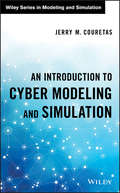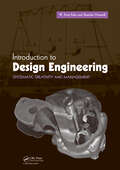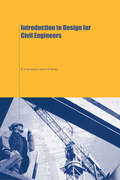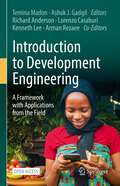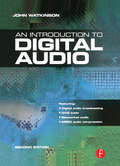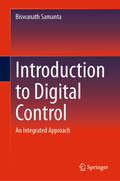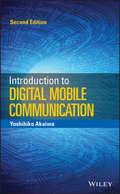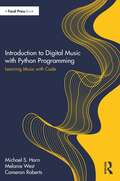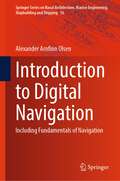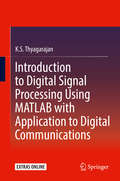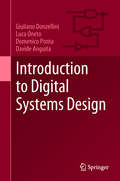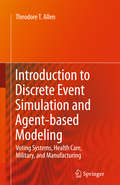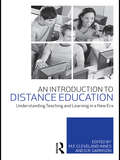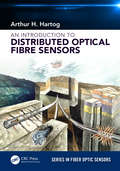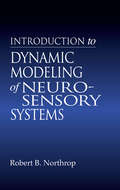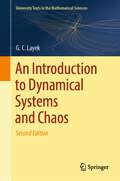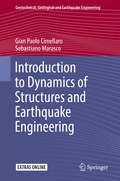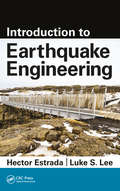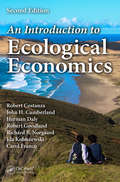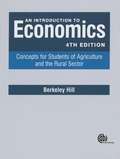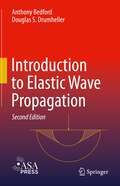- Table View
- List View
An Introduction to Cyber Modeling and Simulation (Wiley Series in Modeling and Simulation #88)
by Jerry M. CouretasIntroduces readers to the field of cyber modeling and simulation and examines current developments in the US and internationally This book provides an overview of cyber modeling and simulation (M&S) developments. Using scenarios, courses of action (COAs), and current M&S and simulation environments, the author presents the overall information assurance process, incorporating the people, policies, processes, and technologies currently available in the field. The author ties up the various threads that currently compose cyber M&S into a coherent view of what is measurable, simulative, and usable in order to evaluate systems for assured operation. An Introduction to Cyber Modeling and Simulation provides the reader with examples of tools and technologies currently available for performing cyber modeling and simulation. It examines how decision-making processes may benefit from M&S in cyber defense. It also examines example emulators, simulators and their potential combination. The book also takes a look at corresponding verification and validation (V&V) processes, which provide the operational community with confidence in knowing that cyber models represent the real world. This book: Explores the role of cyber M&S in decision making Provides a method for contextualizing and understanding cyber risk Shows how concepts such the Risk Management Framework (RMF) leverage multiple processes and policies into a coherent whole Evaluates standards for pure IT operations, "cyber for cyber," and operational/mission cyber evaluations—"cyber for others" Develops a method for estimating both the vulnerability of the system (i.e., time to exploit) and provides an approach for mitigating risk via policy, training, and technology alternatives Uses a model-based approach An Introduction to Cyber Modeling and Simulation is a must read for all technical professionals and students wishing to expand their knowledge of cyber M&S for future professional work.
Introduction to Design Engineering: Systematic Creativity and Management
by W. Ernst Eder Stanislav HosnedlDesigning engineering products � technical systems and/or transformation processes � requires a range of information, know-how, experience, and engineering analysis, to find an optimal solution. Creativity and open-mindedness can be greatly assisted by systematic design engineering, which will ultimately lead to improved outcomes, documentatio
Introduction to Design for Civil Engineers
by A.W. Beeby R.S. NarayananAn Introduction to Design for Civil Engineers is a concise book that provides the reader with the necessary background on terminology used in design. With this book as a guide, entry-level students of civil engineering will better understand from the outset lectures on detailed subject areas. Drawing on a wealth of experience, the authors present a
Introduction to Development Engineering: A Framework with Applications from the Field
by Richard Anderson Kenneth Lee Temina Madon Ashok J. Gadgil Lorenzo Casaburi Arman RezaeeThis open access textbook introduces the emerging field of Development Engineering and its constituent theories, methods, and applications. It is both a teaching text for students and a resource for researchers and practitioners engaged in the design and scaling of technologies for low-resource communities. The scope is broad, ranging from the development of mobile applications for low-literacy users to hardware and software solutions for providing electricity and water in remote settings. It is also highly interdisciplinary, drawing on methods and theory from the social sciences as well as engineering and the natural sciences.The opening section reviews the history of “technology-for-development” research, and presents a framework that formalizes this body of work and begins its transformation into an academic discipline. It identifies common challenges in development and explains the book’s iterative approach of “innovation, implementation, evaluation, adaptation.” Each of the next six thematic sections focuses on a different sector: energy and environment; market performance; education and labor; water, sanitation and health; digital governance; and connectivity. These thematic sections contain case studies from landmark research that directly integrates engineering innovation with technically rigorous methods from the social sciences. Each case study describes the design, evaluation, and/or scaling of a technology in the field and follows a single form, with common elements and discussion questions, to create continuity and pedagogical consistency. Together, they highlight successful solutions to development challenges, while also analyzing the rarely discussed failures. The book concludes by reiterating the core principles of development engineering illustrated in the case studies, highlighting common challenges that engineers and scientists will face in designing technology interventions that sustainably accelerate economic development.Development Engineering provides, for the first time, a coherent intellectual framework for attacking the challenges of poverty and global climate change through the design of better technologies. It offers the rigorous discipline needed to channel the energy of a new generation of scientists and engineers toward advancing social justice and improved living conditions in low-resource communities around the world.
Introduction to Digital Audio
by John WatkinsonMaster the basics from first principles: the physics of sound, principles of hearing etc, then progress onward to fundamental digital principles, conversion, compression and coding and then onto transmission, digital audio workstations, DAT and optical disks. Get up to speed with how digital audio is used within DVD, Digital Audio Broadcasting, networked audio and MPEG transport streams. All of the key technologies are here: compression, DAT, DAB, DVD, SACD, oversampling, noise shaping and error correction theories are treated in a simple yet accurate form. Thoroughly researched, totally up-to-date and technically accurate this is the only book you need on the subject.
Introduction to Digital Communications (Signals and Communication Technology)
by Joachim SpeidelThis book offers students, scientists, and engineers an extensive introduction to the theoretical fundamentals of digital communications, covering single-input single-output (SISO), multiple-input multiple-output (MIMO), and time-variant systems. Further, the main content is supplemented by a wealth of representative examples and computer simulations. The book is divided into three parts, the first of which addresses the principles of wire-line and wireless digital transmission over SISO links. Digital modulation, intersymbol interference, and various detection methods are discussed; models for realistic time-variant, wireless channels are introduced; and the equivalent time-variant baseband system model is derived. This book covers two new topics such as blockwise signal transmission and multicarrier modulation with orthogonal frequency-division multiplexing (OFDM) systems.Since not all readers may be familiar with this topic, Part II is devoted to the theory of linear time-variant systems. The generalized convolution is derived, and readers are introduced to impulse response, the delay spread function, and system functions in the frequency domain. In addition, randomly changing systems are discussed. Several new examples and graphs have been added to this book.In turn, Part III deals with MIMO systems. It describes MIMO channel models with and without spatial correlation, including the Kronecker model. Both linear and nonlinear MIMO receivers are investigated. The question of how many bits per channel use can be transmitted is answered, and maximizing channel capacity is addressed. Principles of space–time coding are outlined in order to improve transmission quality and increase data rates. In closing, the book describes multi-user MIMO schemes, which reduce interference when multiple users in the same area transmit their signals in the same time slots and frequency bands.
Introduction to Digital Control: An Integrated Approach
by Biswanath SamantaThis textbook presents an integrated approach to digital (discrete-time) control systems covering analysis, design, simulation, and real-time implementation through relevant hardware and software platforms. Topics related to discrete-time control systems include z-transform, inverse z-transform, sampling and reconstruction, open- and closed-loop system characteristics, steady-state accuracy for different system types and input functions, stability analysis in z-domain-Jury’s test, bilinear transformation from z- to w-domain, stability analysis in w-domain- Routh-Hurwitz criterion, root locus techniques in z-domain, frequency domain analysis in w-domain, control system specifications in time- and frequency- domains, design of controllers – PI, PD, PID, phase-lag, phase-lead, phase-lag-lead using time- and frequency-domain specifications, state-space methods- controllability and observability, pole placement controllers, design of observers (estimators) - full-order prediction, reduced-order, and current observers, system identification, optimal control- linear quadratic regulator (LQR), linear quadratic Gaussian (LQG) estimator (Kalman filter), implementation of controllers, and laboratory experiments for validation of analysis and design techniques on real laboratory scale hardware modules. Both single-input single-output (SISO) and multi-input multi-output (MIMO) systems are covered. Software platform of Matlab/Simulnik is used for analysis, design, and simulation and hardware/software platforms of National Instruments (NI)/LabVIEW are used for implementation and validation of analysis and design of digital control systems. Demonstrating the use of an integrated approach to cover interdisciplinary topics of digital control, emphasizing theoretical background, validation through analysis, simulation, and implementation in physical laboratory experiments, the book is ideal for students of engineering and applied science across in a range of concentrations.
Introduction to Digital Image Processing
by William K. PrattThe subject of digital image processing has migrated from a graduate to a junior or senior level course as students become more proficient in mathematical background earlier in their college education. With that in mind, Introduction to Digital Image Processing is simpler in terms of mathematical derivations and eliminates derivations of advanced s
Introduction to Digital Media
by Alessandro Delfanti Adam ArvidssonThis book introduces readers to the vast and rich world of digital media. It provides a strong starting point for understanding digital media’s social and political significance to our culture and the culture of others—drawing on an emergent and increasingly rich set of empirical and theoretical studies on the role and development of digital media in contemporary societies. Touching on the core points behind the discipline, the book addresses a wide range of topics, including media economics, online cooperation, open source, social media, software production, globalization, brands, marketing, the cultural industry, labor, and consumption. <p><p> Presented in six sections—Media and Digital Technologies; The Information Society; Cultures and Identities; Digital Collaboration; Public Sphere and Power; Digital Economies—the book offers in-depth chapter coverage of new and old media; network infrastructure; networked economy and globalization; the history of information technologies; the evolution of networks; sociality and digital media; media and identity; collaborative media; open source and innovation; politics and democracy; social movements; surveillance and control; digital capitalism; global inequalities and development; and more.
Introduction to Digital Mobile Communication
by Yoshihiko AkaiwaIntroduces digital mobile communications with an emphasis on digital transmission methods This book presents mathematical analyses of signals, mobile radio channels, and digital modulation methods. The new edition covers the evolution of wireless communications technologies and systems. The major new topics are OFDM (orthogonal frequency domain multiplexing), MIMO (multi-input multi-output) systems, frequency-domain equalization, the turbo codes, LDPC (low density parity check code), ACELP (algebraic code excited linear predictive) voice coding, dynamic scheduling for wireless packet data transmission and nonlinearity compensating digital pre-distorter amplifiers. The new systems using the above mentioned technologies include the second generation evolution systems, the third generation systems with their evolution systems, LTE and LTE-advanced systems, and advanced wireless local area network systems. The second edition of Digital Mobile Communication: Presents basic concepts and applications to a variety of mobile communication systems Discusses current applications of modern digital mobile communication systems Covers the evolution of wireless communications technologies and systems in conjunction with their background The second edition of Digital Mobile Communication is an important textbook for university students, researchers, and engineers involved in wireless communications.
Introduction to Digital Music with Python Programming: Learning Music with Code
by Michael S. Horn Melanie West Cameron RobertsIntroduction to Digital Music with Python Programming provides a foundation in music and code for the beginner. It shows how coding empowers new forms of creative expression while simplifying and automating many of the tedious aspects of production and composition. With the help of online, interactive examples, this book covers the fundamentals of rhythm, chord structure, and melodic composition alongside the basics of digital production. Each new concept is anchored in a real-world musical example that will have you making beats in a matter of minutes. Music is also a great way to learn core programming concepts such as loops, variables, lists, and functions, Introduction to Digital Music with Python Programming is designed for beginners of all backgrounds, including high school students, undergraduates, and aspiring professionals, and requires no previous experience with music or code.
Introduction to Digital Navigation: Including Fundamentals of Navigation (Springer Series on Naval Architecture, Marine Engineering, Shipbuilding and Shipping #16)
by Alexander Arnfinn OlsenThis book focuses on Coastal and Ocean Navigation with an emphasis on digital navigation (using ECDIS) and would be useful to both experienced seafarers as an aide memoire, and also to cadets and trainees embarking on their maritime careers.The text has been developed for modern day ship’s navigator in the ‘digital era’. It is written from the perspective that the reader’s vessel will be navigated using an IMO type-approved electronic chart and display information system (ECDIS) as opposed to traditional chart-based passage planning. As such, the book focuses on the main principles associated with position and direction of the earth's surface, geodesy projects and grids, digital navigation, electronic chart and data information systems, fixing, internal aids to navigation and systems, external aids to navigation, tides and currents, ocean navigation, coastal navigation, pilotage and blind pilotage, anchoring, navigational errors, relative velocity, and bridge organisation and management.
Introduction to Digital Signal Processing Using MATLAB with Application to Digital Communications
by K. S. ThyagarajanThis textbook provides engineering students with instruction on processing signals encountered in speech, music, and wireless communications using software or hardware by employing basic mathematical methods. The book starts with an overview of signal processing, introducing readers to the field. It goes on to give instruction in converting continuous time signals into digital signals and discusses various methods to process the digital signals, such as filtering. The author uses MATLAB throughout as a user-friendly software tool to perform various digital signal processing algorithms and to simulate real-time systems. Readers learn how to convert analog signals into digital signals; how to process these signals using software or hardware; and how to write algorithms to perform useful operations on the acquired signals such as filtering, detecting digitally modulated signals, correcting channel distortions, etc. Students are also shown how to convert MATLAB codes into firmware codes. Further, students will be able to apply the basic digital signal processing techniques in their workplace. The book is based on the author's popular online course at University of California, San Diego.
Introduction to Digital Systems Design
by Davide Anguita Domenico Ponta Luca Oneto Giuliano DonzelliniThis book has been designed for a first course on digital design for engineering and computer science students. It offers an extensive introduction on fundamental theories, from Boolean algebra and binary arithmetic to sequential networks and finite state machines, together with the essential tools to design and simulate systems composed of a controller and a datapath. The numerous worked examples and solved exercises allow a better understanding and more effective learning. All of the examples and exercises can be run on the Deeds software, freely available online on a webpage developed and maintained by the authors. Thanks to the learning-by-doing approach and the plentiful examples, no prior knowledge in electronics of programming is required. Moreover, the book can be adapted to different level of education, with different targets and depth, be used for self-study, and even independently from the simulator. The book draws on the authors’ extensive experience in teaching and developing learning materials.
Introduction to Discrete Event Simulation and Agent-based Modeling
by Theodore T. AllenDiscrete event simulation and agent-based modeling are increasingly recognized as critical for diagnosing and solving process issues in complex systems. Introduction to Discrete Event Simulation and Agent-based Modeling covers the techniques needed for success in all phases of simulation projects. These include: * Definition - The reader will learn how to plan a project and communicate using a charter. * Input analysis - The reader will discover how to determine defensible sample sizes for all needed data collections. They will also learn how to fit distributions to that data. * Simulation - The reader will understand how simulation controllers work, the Monte Carlo (MC) theory behind them, modern verification and validation, and ways to speed up simulation using variation reduction techniques and other methods. * Output analysis - The reader will be able to establish simultaneous intervals on key responses and apply selection and ranking, design of experiments (DOE), and black box optimization to develop defensible improvement recommendations. * Decision support - Methods to inspire creative alternatives are presented, including lean production. Also, over one hundred solved problems are provided and two full case studies, including one on voting machines that received international attention. Introduction to Discrete Event Simulation and Agent-based Modeling demonstrates how simulation can facilitate improvements on the job and in local communities. It allows readers to competently apply technology considered key in many industries and branches of government. It is suitable for undergraduate and graduate students, as well as researchers and other professionals.
Introduction to Discrete Event Systems
by Christos G. Cassandras Stéphane LafortuneThis unique textbook comprehensively introduces the field of discrete event systems, offering a breadth of coverage that makes the material accessible to readers of varied backgrounds. The book emphasizes a unified modeling framework that transcends specific application areas, linking the following topics in a coherent manner: language and automata theory, supervisory control, Petri net theory, Markov chains and queueing theory, discrete-event simulation, and concurrent estimation techniques. Topics and features:detailed treatment of automata and language theory in the context of discrete event systems, including application to state estimation and diagnosiscomprehensive coverage of centralized and decentralized supervisory control of partially-observed systemstimed models, including timed automata and hybrid automatastochastic models for discrete event systems and controlled Markov chainsdiscrete event simulationan introduction to stochastic hybrid systemssensitivity analysis and optimization of discrete event and hybrid systemsnew in the third edition: opacity properties, enhanced coverage of supervisory control, overview of latest software toolsThis proven textbook is essential to advanced-level students and researchers in a variety of disciplines where the study of discrete event systems is relevant: control, communications, computer engineering, computer science, manufacturing engineering, transportation networks, operations research, and industrial engineering. Christos G. Cassandras is Distinguished Professor of Engineering, Professor of Systems Engineering, and Professor of Electrical and Computer Engineering at Boston University. Stéphane Lafortune is Professor of Electrical Engineering and Computer Science at the University of Michigan, Ann Arbor.
An Introduction to Distance Education: Understanding Teaching and Learning in a New Era
by M.F. Cleveland-Innes D. R. GarrisonAn Introduction to Distance Education is a comprehensive look at the field today, outlining current theories, practices and goals. The book reviews the influence of past distance education theory and practice, along with current changes. It outlines the practical skills and information that are essential to effective distance education design, delivery and navigation. This volume brings together seminal contributors who have and who are currently researching and shaping our understanding and practice of distance education. A discussion of past and present practices in higher and distance education leads to an understanding of accessible education and the appropriate use of Web 2.0 technology. Utilizing a student-guided approach, each chapter offers pedagogical features to engage and support the teaching and learning process, including: questions for reflection, review and discussion: students can use these questions as triggers for further thoughts related to the topic. Instructors can use these questions for classroom and online discussion key quotations: strategically placed throughout the text, these points act as a springboard for further reflection and classroom discussion concept definitions: central concepts discussed in the text are defined or students at the end of each chapter. A perfect textbook for educational technology Doctorate, Masters and Certificate programs, students will find An Introduction to Distance Education offers a solid foundation from which to explore and develop new approaches to designing and implementing online courses.
An Introduction to Distributed Optical Fibre Sensors (Series in Fiber Optic Sensors)
by Arthur H. HartogThis book explains physical principles, unique benefits, broad categories, implementation aspects, and performance criteria of distributed optical fiber sensors (DOFS). For each kind of sensor, the book highlights industrial applications, which range from oil and gas production to power line monitoring, plant and process engineering, environmental monitoring, industrial fire and leakage detection, and so on. The text also includes a discussion of such key areas as backscattering, launched power limitations, and receiver sensitivity, as well as a concise historical account of the field’s development.
Introduction to Dynamic Modeling of Neuro-Sensory Systems (Biomedical Engineering)
by Robert B. NorthropAlthough neural modeling has a long history, most of the texts available on the subject are quite limited in scope, dealing primarily with the simulation of large-scale biological neural networks applicable to describing brain function. Introduction to Dynamic Modeling of Neuro-Sensory Systems presents the mathematical tools and methods that can de
An Introduction to Dynamical Systems and Chaos (University Texts in the Mathematical Sciences)
by G. C. LayekThis book discusses continuous and discrete nonlinear systems in systematic and sequential approaches. The unique feature of the book is its mathematical theories on flow bifurcations, nonlinear oscillations, Lie symmetry analysis of nonlinear systems, chaos theory, routes to chaos and multistable coexisting attractors. The logically structured content and sequential orientation provide readers with a global overview of the topic. A systematic mathematical approach has been adopted, featuring a multitude of detailed worked-out examples alongside comprehensive exercises. The book is useful for courses in dynamical systems and chaos and nonlinear dynamics for advanced undergraduate, graduate and research students in mathematics, physics and engineering. The second edition of the book is thoroughly revised and includes several new topics: center manifold reduction, quasi-periodic oscillations, Bogdanov–Takens, period-bubbling and Neimark–Sacker bifurcations, and dynamics on circle. The organized structures in bi-parameter plane for transitional and chaotic regimes are new active research interest and explored thoroughly. The connections of complex chaotic attractors with fractals cascades are explored in many physical systems. Chaotic attractors may attain multiple scaling factors and show scale invariance property. Finally, the ideas of multifractals and global spectrum for quantifying inhomogeneous chaotic attractors are discussed.
Introduction to Dynamics of Structures and Earthquake Engineering (Geotechnical, Geological And Earthquake Engineering Ser. #45)
by Gian Paolo Cimellaro Sebastiano MarascoThis work is an elementary but comprehensive textbook which provides the latest updates in the fields of Earthquake Engineering, Dynamics of Structures, Seismology and Seismic Design, introducing relevant new topics to the fields such as the Neodeterministic method. Its main purpose is to illustrate the application of energy methods and the analysis in the frequency domain with the corresponding visualization in the Gauss-Argant plan. However, emphasis is also given to the applications of numerical methods for the solution of the equation of motion and to the ground motion selection to be used in time history analysis of structures. As supplementary materials, this book provides “OPENSIGNAL", a rare and unique software for ground motion selection and processing that can be used by professionals to select the correct earthquake records that would run in the nonlinear analysis. The book contains clear illustrations and figures to describe the subject in an intuitive way. It uses simple language and terminology and the math is limited only to cases where it is essential to understand the physical meaning of the system. Therefore, it is suitable also for those readers who approach these subjects for the first time and who only have a basic understanding of mathematics (linear algebra) and static analysis of structures.
Introduction to Earthquake Engineering
by Hector Estrada Luke S. LeeThis book is intended primarily as a textbook for students studying structural engineering. It covers three main areas in the analysis and design of structural systems subjected to seismic loading: basic seismology, basic structural dynamics, and code-based calculations used to determine seismic loads from an equivalent static method and a dynamics-based method. It provides students with the skills to determine seismic effects on structural systems, and is unique in that it combines the fundamentals of structural dynamics with the latest code specifications. Each chapter contains electronic resources: image galleries, PowerPoint presentations, a solutions manual, etc.
An Introduction to Ecological Economics
by Carol Franco Robert Costanza Herman Daly Robert Goodland Richard B Norgaard Ida Kubiszewski John H CumberlandFrom Empty-World Economics to Full-World EconomicsEcological economics explores new ways of thinking about how we manage our lives and our planet to achieve a sustainable, equitable, and prosperous future. Ecological economics extends and integrates the study and management of both "nature's household" and "humankind's household"-An Introduction to
An Introduction to Economics
by Berkeley HillThis book provides a simple but effective introduction to economics. Fully updated and revised, this fourth edition incorporates the recent changes that have taken place in the environment in which agriculture operates. Covering the impacts of the EU expansion to 28 Member States, major changes to financial support of agriculture, financial crises, economic recession and, in many countries, high levels of unemployment, it provides a rounded and up to date introduction to the subject. The inclusion of chapter-focused exercises, essay questions and further reading suggestions make this textbook an invaluable learning tool for students of agriculture, economics and related sectors.
Introduction to Elastic Wave Propagation
by Anthony Bedford Douglas S. DrumhellerThis revised and updated edition expands on its explanations of methods used to analyze waves in solid materials, such as the waves created by earthquakes and the ultrasonic waves used to detect flaws in materials and for medical diagnoses. In addition to the traditional methods used to analyze steady-state and transient waves in elastic materials, the book contains introductions to advanced areas that no other single text covers. These topics include the use of finite elements to solve wave problems, the Cagniard-de Hoop method, the four-pole technique for analyzing waves in layered media, and the growth and decay of shock and acceleration waves. The authors explain the theory of linear elasticity through the displacement equations of motion, methods used to analyze steady-state and transient waves in layered media, and include an appendix on functions of a complex variable. Originally developed for a graduate course for which no suitable text existed, the new edition retains its classroom-tested treatment of the theories of linear elasticity and complex variables for students needing background in those subjects.
